
USS Saratoga CV-3
by Tony DiGiulian
Updated 20 June 2013

USS Saratoga CV-3
USS Saratoga CV-3
21 February 1945: Attacked by six Zero fighters, with two bouncing
off the water into the starboard side, one hitting the flight deck forward,
the fourth hitting a large crane and the last two being shot down by AA
fire. In addition, three bombs from these planes exploded inside
the hull. Saratoga's flight deck forward was wrecked, her starboard
side was holed in two places with large fires started in her hangar deck
and she lost 123 of her crew dead or missing. Another attack at 1900
scored an additional bomb hit, believed to have been a 500 kg bomb, but
the kamikaze itself did little damage and slid over the side. By
2015, the fires were under control and the carrier was able to recover
aircraft. She was ordered to Eniwetok and then to the west coast
for repairs, arriving at Bremerton on 16 March. On 22 May, Saratoga
departed Puget Sound fully repaired and she resumed training pilots at
Pearl Harbor on 3 June.
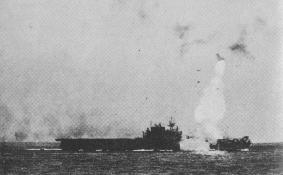
USS Enterprise CV-6
Hit by kamikaze on 14 May 1945. Note the portion of the elevator
at the top of the explosion plume.
USS Enterprise CV-6
1) 11 April 1945 - Hit by a Yokosuka "Judy" right aft, with its 500
kg bomb exploding at the turn of the bilge near the after machinery spaces,
causing severe shock damage. An hour later, another "Judy" near-missed
near her starboard bow and its bomb went off close aboard, causing some
additional underwater damage. Five men were wounded from these attacks
and one man was blown overboard, but later rescued. Enterprise continued
with her flight duties, launching strikes on Okinawa and islands in the
Amami group for three more days before being detached. She was repaired
at Ulithi for sixteen days and was off Okinawa once more on 6 May.
2) 14 May 1945: The "Big E" suffered her last wound of World
War II when a bomb-laden Zero flown by Chief Pilot Tomi Zai destroyed her
forward elevator, killing 14 and wounding 34 men. The bomb penetrated
to the third deck where it detonated in a rag storeroom. A large
fire was started in the elevator pit and among the deck park aircraft.
The carrier sailed for repairs at Puget Sound Navy Yard, arriving 7 June
1945. Repairs were slowed by the end of the war but completed on
13 September 1945 at which time she was "restored to peak condition" according
to her DANFS entry. She never operated aircraft again but took part
in "Operation Magic Carpet" before she was decommissioned on 17 February
1947.
Essex CV-9
1) 25 November 1944: A kamikaze hit the port edge of her flight
deck, striking planes ready and fueled for takeoff, causing extensive damage
with 15 killed and 44 wounded. Thirty minutes later she was capable
of launching and landing planes. The damage was quickly repaired
and she was back with the 3d Fleet off Luzon supporting the occupation
of Mindoro during 14-16 December 1944.
2) 11 April 1945: Near-missed by a kamikaze which caused very
slight damage.
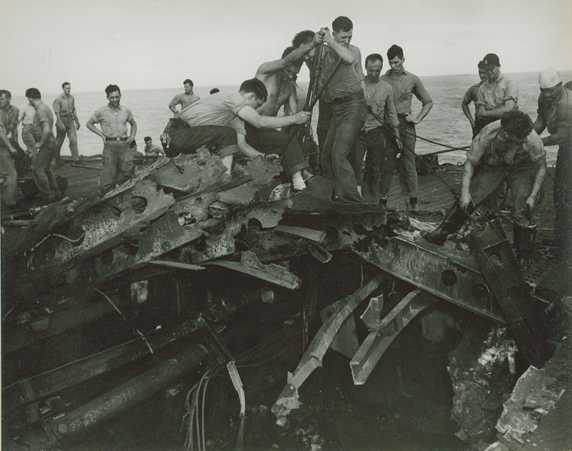
USS Intrepid CV-11
Repairing flight deck damage following 16 April 1945 attack
Intrepid CV-11
1) 30 October 1944: A burning kamikaze crashed into one of the
carrier's port gun tubs killing 10 men and wounding 6. Resumed flight
operations within hours.
2) 25 November 1944: Hit by 2 kamikazes within five minutes,
killing 11. Intrepid suffered no propulsion casualties nor left her
station in the task group. In less than 2 hours her crew had extinguished
the last blaze. Intrepid headed for San Francisco the next day, arriving
20 December for repairs. Rejoined the fleet in mid-February 1945.
3) 18 March 1945: A twin engine "Betty" exploded about 50 feet
off Intrepid's forward boat crane. Flaming gasoline and plane parts
started fires on the hangar deck but these were quickly extinguished.
4) 16 April 1945: Kamikaze struck Intrepid's flight deck.
The engine and part of her fuselage went right on through to the hanger
deck, killing 8 men and wounding 21. In less than an hour the flaming
gasoline had been extinguished and within 3 hours after the crash planes
were again landing on the carrier. Repaired San Francisco 19 May
to 29 June 1945. On 6 August her planes attacked Wake Island as a
"live fire" exercise, her last combat operation of the war.
USS Franklin CV-13
1) 9 October 1944: Kamikaze hit on Franklin's deck abaft the
island structure, slid across the deck and into the water on her starboard
beam. This strike resulted in no casualties and minor damage to the
ship with no interruption to flight operations.
2) 30 October 1944: Attacked by three kamikazes. The first
struck off her starboard side, the second hit the flight deck and broke
through onto the gallery deck, killing 56 and wounding 60. 33 aircraft
were destroyed. The third plane nearly hit the Franklin before diving
into the flight deck of Belleau Wood. Repaired at Bremerton 28 November
1944 to 2 February 1945.
3) 19 March 1945 (This damage is not kamikaze related but is included
here for reference): Struck by two semi-armor piercing (SAP) bombs.
One struck the flight deck centerline, penetrating to the hangar deck,
igniting fires on the second and third decks as well as knocking out the
combat information center and airplot. The second hit aft, tearing
through two decks and starting fires which triggered ammunition, bombs
and rockets. Franklin, within 50 miles of the Japanese mainland,
lay dead in the water, took a 13 degree starboard list, lost all radio
communications and had massive fires. The casualties totaled 724
killed and 265 wounded. Franklin was taken in tow by the cruiser
USS Pittsburgh until she managed to work up enough steam to make 14 knots.
Franklin proceeded to Pearl Harbor on her own power where temporary repairs
permitted her to sail to Brooklyn, NY, where she arrived on 28 April 1945.
During repairs, everything from the hangar floor up, except the island
and forward flight deck, was removed and replaced. As she was determined
to be surplus to requirements following the end of the war, she did not
resume flight operations and was decommissioned to reserve on 17 February
1947. Contrary to many reports, at this time she was actually in
excellent condition and was held in reserve for a potential "ultimate"
Essex class conversion. The forward portion of her flight deck was
removed in 1959 and used to repair the storm-damaged USS Valley Forge (CVS-45).
Ultimately, Franklin was found again to be surplus to requirements and
she was stricken from the Naval Vessel Register in 1964 and scrapped a
few years later.
USS Ticonderoga CV-14
21 January 1945: Kamikaze crashed through her flight deck abreast
of the No. 2 5-inch mount with a bomb exploding just above her hangar deck.
Several planes stowed nearby were caught in the explosion and set on fire.
Damage and water from firefighting created a 10-degree list to starboard,
requiring counterflooding to correct. Captain Kiefer instituted a
unique damage control operation by instructing the damage control party
to continue flooding compartments on Ticonderoga's port side until she
took on a 10-degree list to port. This swing from a starboard to
a port list neatly dumped the burning planes overboard. Shortly after
this performance, a second kamikaze struck the carrier's starboard side
near the island. This bomb set more planes on fire, riddled her flight
deck, and injured or killed another 100 sailors, including Capt. Kiefer.
A total of 143 men were killed and 202 injured from the two attacks.
The crew brought her fires completely under control not long after 1400,
about two hours after the first Kamikaze hit. Sent to Puget Sound
Navy Yard where she arrived on 15 February. Repairs were completed
on 20 April 1945 and she departed the next day to rejoin the fleet, striking
at the Marshall Islands in early May.
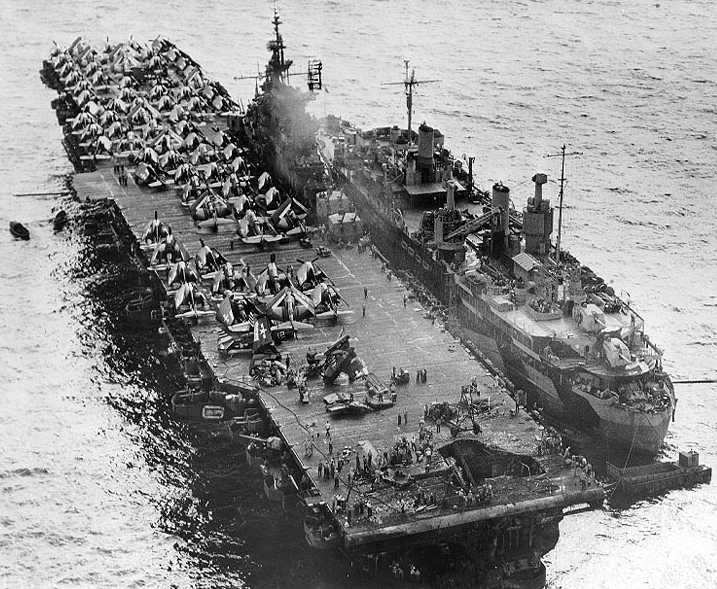
USS Randolph CV-15
Note damaged aircraft
USS Randolph CV-15
11 March 1945: While anchored at Ulithi, a "Frances" twin-engine
bomber carrying a 750 kg bomb hit Randolph on the starboard side aft just
below the flight deck, killing 25 men and wounding 106. Repaired
at Ulithi, Randolph joined the Okinawa Task Force on 7 April 1945.
USS Lexington CV-16
5 November 1944: Off Luzon a Kamikaze struck near her island,
destroying most of the island structure and starting multiple fires.
Within 20 minutes major blazes were under control and she was able to continue
normal flight actions. Repaired at Ulithi and back in action 1 December
1944.
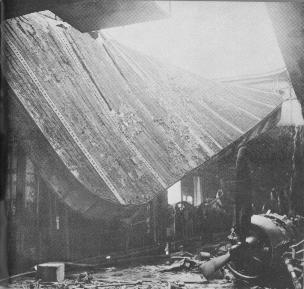
USS Bunker Hill CV-17
The forward elevator and hanger deck.
USS Bunker Hill CV-17
11 May 1945: Severely damaged by two suicide planes which started
large fires and explosions. Casualties were 346 men killed, 43 missing,
and 264 wounded. Fully repaired at Bremerton from June to September
1945. With the end of the war, she was converted for use in "Operation
Magic Carpet" and did not operate aircraft again. Decommissioned
on 9 January 1947 and then held in reserve for a potential "ultimate" Essex
class conversion. Found surplus to requirements and stricken from
the Naval Vessel Register in November 1966.
USS Hancock CV-19
1) 25 November 1944: Antiaircraft fire exploded a Kamikaze plane
some 300 feet above the ship but a section of its fuselage landed amidships
and a part of the wing hit the flight deck and burst into flames.
The fires were quickly extinguished and no serious damage was inflicted,
but 15 men were killed.
2) 7 April 1945: Kamikaze spun across the flight deck and crashed
into a group of planes while its bomb hit the port catapult. 62 men
were killed and 71 wounded. The fires were out within a half hour
and she resumed flight operations in less than an hour. Hancock was
detached from her task group 9 April and was sent to Pearl Harbor for repairs.
She was back in action on 13 June 1945.
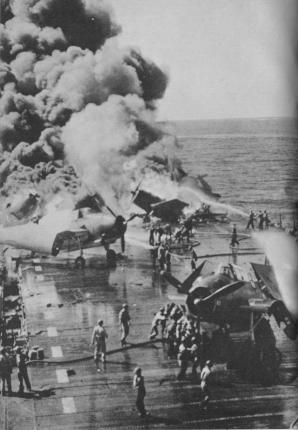
USS Belleau Woods CVL-24
USS Belleau Wood CVL-24
30 October 1944: Shot down a "Jill" Kamikaze which fell on her
flight deck aft, causing fires and setting off ammunition. 92 men
were killed or missing and another 54 were injured. 12 aircraft were
destroyed. After temporary repairs at Ulithi during 2-11 November,
Belleau Wood was sent to Hunter's Point for permanent repairs and an overhaul,
arriving 29 November. She departed San Francisco Bay back to the
fleet on 20 January 1945, joining TF 58 at Ulithi on 7 February 1945.
USS Cabot CVL-28
25 November 1945: Kamikaze crashed the flight deck on the port
side, destroying or disabling several AA guns and a gun director.
A second Kamikaze was shot down but struck close aboard, showering the
port side with shrapnel and burning debris. Cabot lost 62 men killed
and wounded but she continued to maintain her station in formation and
operate aircraft as temporary repairs were made. Sent to Ulithi for
permanent repairs, arriving 28 November and returning to action on 11 December
1944.
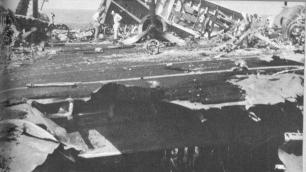
USS Sangamon CVE-26
USS Sangamon CVE-26
4 May 1945: Struck by a Kamikaze and its bomb load at 1933.
The bomb and parts of the plane penetrated the flight deck and exploded
below. Initial damage was extensive with fires on the flight deck,
the hangar deck and the fuel deck. Communications with the bridge
were lost within 15 minutes. The ship was soon out of control and
swinging through the wind which caused the flames and smoke to change direction
and hinder fire-fighting efforts, spreading the fires. By 2015, after
steering had established steering control and brought the ship back to
a course which helped the crew effectively fight the many fires.
By 2230, all fires were under control. Casualties were 11 dead, 25
missing, and 21 seriously wounded. Repaired at Norfolk starting 12
June but in mid-August, when the Japanese surrendered, all work was halted
and she decommissioned on 24 October 1945.
USS Suwanee CVE-27
1) 25 October 1944: A Zero fighter plane struck about 40
feet forward of the after elevator, opening a 10-foot hole in her flight
deck. A bomb carried by this Kamikaze exploded between the flight
and hangar decks, tearing a 25-foot gash in the latter and causing a number
of casualties. Within two hours, her flight deck was sufficiently
repaired to enable the resumption of air operations.
2) 26 October 1944: A Zero fighter plane struck the flight deck
and then smashed into a torpedo bomber which had just been recovered.
This plane plus nine others were caught in the resulting explosion, starting
a fire which burned for several hours, but was finally brought under control.
150 men were killed and 100 more injured. The escort carrier was
sent to Kossol Roads in the Palaus on 28 October, then to Manus for temporary
repairs between 1 and 6 November 1944. Sent on to Puget Sound Navy
Yard where she arrived on 26 November. Repairs were completed 31
January 1945.
USS Santee CVE-29
25 October 1944: At 0740, a Japanese plane with an estimated
63 kilogram bomb struck and penetrated through the flight deck, stopping
on the hangar deck. The fire was under control in eleven minutes
but sixteen men were killed. At 0756, a torpedo from the Japanese
submarine I-56 struck the ship, causing the flooding of several compartments
and a six degree list. Interestingly, the USN thought that this damage
was from a jettisoned depth charge and did not recognize it as being from
a torpedo, even when the hull was examined in drydock, until after the
war. Emergency repairs were completed by 0935 and she resumed air
operations. Temporary repairs were undertaken at Seeadler Harbor
and then Pearl Harbor, after which she departed for San Diego for permanent
repairs which took about one month to complete. Departed San Diego
on 31 January 1945.
USS Manila Bay CVE-61
5 January 1945: Just before 1750, Manila Bay was attacked on
the portside by two Zero fighters. The first plane hit the flight
deck to starboard abaft the bridge, causing fires on the flight and hangar
decks, destroying two torpedo planes, radar transmitting spaces and wiping
out all communications. The second plane, aiming for the bridge,
missed the island close aboard to starboard and splashed off the fantail.
Firefighting parties promptly brought the blazes under control. Casualties
were 14 men killed and 52 wounded. Within 24 hours, she resumed limited
air operations. Most repairs to her damaged electrical and communication
circuits were completed by 9 January, when the amphibious invasion in Lingayen
Gulf got underway. By 10 January she resumed full duty in support
of the Lingayen Gulf operations until 17 January when she was detached.
Arrived at San Diego 15 February and battle damage repairs were completed
late in April 1945.
USS Natoma Bay CVE-62
7 June 1945: At 0635 attacked by a Zero fighter plane, which
fired incendiary ammunition at the bridge and then crashed onto the flight
deck. The engine, propeller and a bomb tore a hole in the flight
deck, 12 by 20 feet, while the explosion of the bomb damaged the deck of
the foc'sle and the anchor windlass beyond repair and ignited a nearby
fighter. One ship's officer was killed, three crewmen and one officer
of VC-9 were wounded. The fires were immediately extinguished by
the damage control party. The next strike was cancelled, but the
following one, against Miayako Shima, took place as scheduled at 1030.
On 20 June, the escort carrier headed for Guam for temporary repairs, then
continued on to the United States. When she arrived at San Diego
on 19 August the war was over. During September and October she underwent
repairs, alterations and general overhaul after which she was used as a
"Magic Carpet" transport. Decommissioned 20 May 1946.
USS St. Lo (ex -USS Midway) CVE-63
25 October 1944: During Battle of Leyte Gulf, one plane crashed
through St. Lo's flight deck at 1051. The damage from the plane itself
was not serious, as it slid up the deck and over the bows, but its bomb
exploded in the hanger and set fire to the aircraft and gasoline fuel system.
This fire eventually exploded her torpedo and bomb magazine. St.
Lo was badly damaged and sank a half hour later. This has nothing
to do with Kamikazes, but I would just like to mention here that during
this battle St. Lo scored a direct hit amidships on a Japanese destroyer
with her single 5" gun, possibly making her the only carrier ever to damage
an enemy ship by surface gunfire.
USS Wake Island CVE-65
3 April 1945: At 1744, a Japanese single-engine plane missed
the port forward corner of the flight deck, exploding in the water abreast
the forecastle. Thirty seconds later, a second single-engine plane
narrowly missed the bridge structure and struck the water about 10 feet
from the hull. This plane exploded after impact, ripping a hole in
the ship's side below the waterline, about 45 feet long and about 18 feet
from top to bottom and as well as causing many shrapnel holes. Parts
of the plane were thrown onto the forecastle and into the gun sponsons.
Various compartments were flooded, and the shell plating was cracked between
the first and second decks. Other shell plating was buckled and the
main condensers were flooded with salt water, which contaminated about
30,000 gallons of fresh water and 70,000 gallons of fuel oil. At
1824, salting made it necessary to secure the forward engine, and the ship
proceeded on one propeller. Despite this damage, there were no casualties
and by 2140 corrective measures had been taken and the ship was again steaming
on both engines. The next day she went to Kerama Retto anchorage
for temporary repairs. The escort carrier then set course for Guam
on 6 April 1945 and arrived at Apra Harbor four days later for repairs
in drydock which lasted through 20 May. The next day, she headed
for Okinawa where she resumed her mission of supporting the troops on the
island.
USS White Plains CVE-66
25 October 1944: Damaged by surface gunfire during the Leyte
Gulf battle and then attacked by two kamikazes. Her antiaircraft
gunners scored a hit on one of these which immediately changed course and
succeeded in crashing into the USS St. Lo CVE-63, which fatally damaged
that carrier. The second plane was shot down a few yards astern.
The explosion from this Kamikaze scattered debris all over her flight deck
and sides but caused only 11 relatively minor casualties and very little
additional damage. However, as the gunfire damage was significant,
she was sent back to the United States for repairs, arriving at San Diego
on 27 November 1944 where she was repaired. Deployed back to the
war zone on 19 January 1945.
USS Kalinin Bay CVE-68
25 October 1944: Damaged by surface gunfire during the Leyte
Gulf battle. Later attacked by four Kamikazes from astern and the
starboard quarter. Anti-aircraft fire shot down two attackers close
aboard, but the third plane crashed into the port side of the flight deck,
damaging it badly. The fourth plane hit and destroyed the aft port
stack. The Kalinin Bay suffered extensive structural damage, with
5 dead and 55 wounded. Sent to Manus for temporary repairs, arriving
1 November. Getting under way for the United States 7 November, the
escort carrier reached San Diego on 27 November, where she was repaired
and modified until 18 January 1945.
USS Kitkun Bay CVE-71
1) 25 October 1944: During the Leyte Gulf battle a Zero fighter
plane struck the port catwalk killing 1 man and wounding 16. Repairs
at Pearl Harbor completed 17 December 1944.
2) 8 January 1945: At 1857 an "Oscar" Kamikaze struck the
portside amidships at the waterline. Almost simultaneously, a "friendly-fire"
5-inch shell struck her starboard side. The resultant fires and flooding
were brought under control but 16 were dead and 37 wounded. The following
day with a list and only one engine operating she withdrew and proceeded
by stages to Leyte, Manus and Pearl Harbor, finally arriving at San Pedro
on 28 February 1945. Repairs took two months.
USS Kadashan Bay CVE-76
8 January 1945: An "Oscar" struck the ship amidships directly
below the bridge. Fires and flooding were checked after one and a
half hours and there was no loss of life. Too badly damaged to continue
full operations, she flew off her aircraft to other carriers. Temporary
repairs took place at Leyte on 12 January. Arrived at San Francisco
where she received a complete overhaul between 13 February and 8 April
1945.
USS Marcus Island CVE-77
15 December 1944: Near-missed by two Zero Kamikazes on the morning
of the invasion of Mindoro, one of which clipped the flight deck causing
minor damage and several casualties.
USS Savo Island CVE-78
5 January 1945: Minor damage caused by a near-miss Kamikaze which
the ship blinded by shining her searchlight into the pilot's face.
The plane's wingtip clipped a radar antenna. No interruption of flight
operations.
USS Ommaney Bay CVE-79
4 January 1945: Hit on the after end of the island by a Kawasaki
"Nick" fighter carrying two bombs. Damage inflicted was severe and
she was abandoned and then sunk by the escorting USS Burns DD-588.
95 men were killed, including two on an escorting DE when a torpedo warhead
cooked off.
USS Lunga Point CVE-94
21 February 1945: Attacked by four "Jill" bombers making torpedo
runs. All three torpedoes launched by the attacking planes were avoided,
but one plane decided to turn into an impromptu kamikaze after dropping
its torpedo. This one merely clipped the island with its wing tip
and skidded across the flight deck, leaving minor fires in its wake before
it went into the sea. Fires were quickly put out and there was no
interruption to flight operations.
USS Bismarck Sea CVE-95
Hit by two kamikazes off Iwo Jima 21 February 1945. Badly damaged
by the attack, she sank about 90 minutes later with the loss of 218 men.
USS Salamaua CVE-96
13 January 1945: Just before 0900 struck on the flight deck by
a Kamikaze, possibly a Nakajima "Frank," carrying two 250 kg. bombs.
15 Killed and over eighty wounded. The flight deck, the hangar deck
and interior spaces were set on fire. One of the bombs failed to
explode and created an exit hole on the starboard side at the waterline.
Power, communications, and steering failed. One of her engine rooms
flooded and the starboard engine was stopped. Temporary repairs were
made on-board and she left with a Leyte-bound convoy that night. She was
sent back to the States and repaired at San Francisco between 26 February
and 21 April 1945.
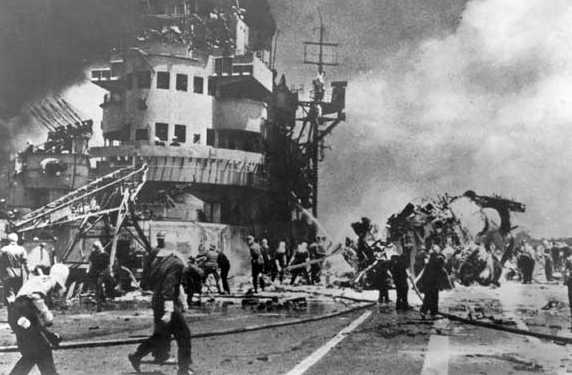
HMS Formidable
Kamikaze hit of 4 May 1945
HMS Formidable
1) 4 May 1945: Struck by a Zero carrying one 250 kg bomb which
created a 2 foot square hole and a 24 x 20 foot depression in the armored
flight deck. Some structural damage was inflicted with splinters
entering many of the compartments in the island and three fragments penetrating
the hanger deck with one going through the center boiler room and into
the double bottom, severing steam pipes and piercing A6 oil fuel tank.
Speed was reduced to 18 knots for a time and all radars except the Type
277 were out of action for five hours. This attack killed eight men,
wounded 51 and destroyed eleven aircraft.* The hole in the flight
deck was temporarily patched with wood and concrete with thin steel plates
tack welded on top. Was able to operate aircraft by the next morning.
2) 9 May 1945: Kamikaze strike into the after deck park killed
one and wounded eight. Deck depressed 4.5 inches with a supporting
beam distorted by 3 inches. Six Corsairs and one Avenger were destroyed
on deck, and a blown out rivet allowed burning fuel to penetrate into the
hanger, which together with the sprinkler system damaged a further eight
Corsairs and three Avengers. Able to launch and land aircraft 50
minutes later but only had four Avengers and eleven Corsairs left serviceable
at this time.*
HMS Illustrious
6 April 1945: A Judy (D4Y3) kamikaze struck a glancing blow to
the island with the only apparent damage being a hole in the Type 272 radome
forward of the bridge. However, after the plane skidded into the
sea, its bomb exploded underwater close alongside. This inflicted
severe structural damage, with the outer hull opened up and some of the
frames cracked. The damage did not interrupt flight operations, but
speed was limited to 19 knots. Sent home and arrived at Rosyth on
27 June 1945 for what was intended to be a four month repair and refit,
but the end of the war slowed work and changed plans. She recommissioned
in June 1946 as a trials and training carrier, replacing HMS Pretoria Castle.
HMS Indefatigable
1 April 1945: Struck by a Zero carrying one 250 kg bomb on the
starboard side of island at the junction with the flight deck. Deck
indented over 15 square feet by up to 3 inches but not penetrated.
Much superficial damage inflicted by splinters and an intense fire started,
but the fire was quickly brought under control and extinguished.
Eight killed and sixteen wounded. Able to land Seafires about forty
minutes after attack.* Repaired between 2 April and 1 May.
HMS Indomitable
4 May 1945: A Zero Kamikaze belly-landed next to the island but
broke up and went over the side. Destroyed the Type 282 radar aerials
of the port midships AA directors but inflicted no serious damage to the
ship. A bomb attached to the kamikaze exploded after the plane went
into the water but this also inflicted no damage.
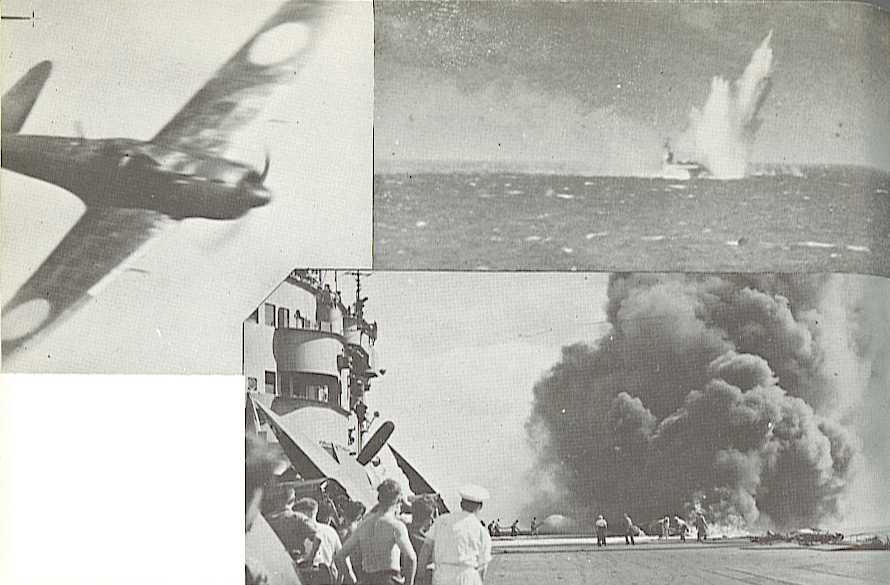
A montage of the Kamikaze strikes on HMS Victorious
Left: A Zeke 52 as taken from the bridge a second before it hit
the carrier
Right: Kamikaze going into the sea 80 feet from Victorious on
1 April 1945
Bottom: Fire started by second Kamikaze hit on 9 May 1945
HMS Victorious
1 April 1945: Attacked by a Kamikaze Zero which struck its starboard
wing against the port side of the flight deck, causing the plane to cartwheel
into the sea where its 250 kg bomb exploded underwater about 80 feet from
the ship's side. Tons of water, fuel and fragments of both plane
and pilot were thrown on the deck, but the ship escaped damage.
9 May 1945: Struck by two kamikazes. The first was a Zero
making a shallow dive which hit the flight deck at Frame 30 near the forward
lift (elevator), slid across the deck and into "B2" 4.5-in mount.
This hit created a 25 sq. ft. hole and depressed the deck over an area
of 144 sq. ft. In addition, bulkheads in the area were buckled, both
"B" group 4.5" mountings were put out of action with one gun barrel destroyed,
the ship's accelerator [a type of aircraft catapult] was broken and small
fires were started.** The second kamikaze hit a glancing blow against
the port side aft, destroying four Corsairs and a 40 mm gun director.
This hit also put an arrestor unit out of action. The two attacks
killed four, seriously wounded four more and less-seriously wounded an
additional twenty. Victorious was able to fly off planes one hour
later and could land planes twelve hours later. Fully back in action
after two days. Repairs took one month.
Notes:
Japanese Naval Planes Used from Oct. 1944 to the end of the Okinawa
Campaign1
(including Escorts)
Sortied
2,314
Returned 1,086
Expended 1,228
Okinawa Campaign Losses2
During just the Okinawa campaign, the Japanese Army and Navy forces combined lost 1,900 aircraft in suicide attacks, 2,255 in combat operations, 2,655 in operational accidents and more than 1,000 destroyed on the ground. In contrast, the US fleet during this time lost 665 aircraft including those washed overboard duing a hurricane on 5 June 1945. The British Pacific Fleet lost 160 planes - 26 shot down or otherwise lost in combat, 72 lost in operating accidents of which 61 were Seafire deck-landing accidents, 32 destroyed by Kamikaze hits and 30 lost in the accidental hanger fire on Formidable. In addition, there were 43 "duds" which needed repairs that could not be performed on-board. As the four British Pacific Fleet carriers started out with a total of 218 operational aircraft, these losses put a severe strain on the replenishment system but 140 replacement planes were provided during the course of the Okinawa campaign.
USN Ships Sunk and Damaged by Kamikazes3
| Sunk | Damaged | |||
| Ship Type | Qty | Ship Type | Qty | |
| CVE | 3 | CV | 16 | |
| DD | 13 | CVL | 3 | |
| DE | 1 | CVE | 17 | |
| DMS | 2 | BB | 15 | |
| SC | 1 | CA | 5 | |
| AM | 1 | CL | 10 | |
| APD | 3 | DD | 87 | |
| LST | 5 | DE | 24 | |
| ATO | 1 | SS | 1 | |
| Auxiliary | 1 | DM | 13 | |
| PC/PT | 3 | DMS | 15 | |
|
Total
|
34 | AGP/AGS | 3 | |
| AH | 1 | |||
| AK/AKA/AKN | 6 | |||
| AM | 10 | |||
| AO | 2 | |||
| APA/APD/APH | 30 | |||
| ARL | 2 | |||
| ATF | 1 | |||
| AV/AVP | 4 | |||
| CM | 1 | |||
| LST | 11 | |||
| PC/PT | 3 | |||
| YDG/YMS | 7 | |||
|
Total
|
288 |
Notes:
For US Carriers
Brown, David
- "Kamikaze"
Friedman, Norman
- "US Aircraft Carriers: An Illustrated Design
History"
Inoguchi, Rikihei, Nakajima, Tadashi and Pineau, Roger
- "The Divine Wind"
Silverstone, Paul
- "US Warships of World War II"
Stafford, Edward P.
- "The Big E: The Story of the USS Enterprise"
US Navy Website at http://www.navy.mil
US Navy Historical Center at http://www.history.navy.mil/
"Dictionary of American Fighting Ships" carrier histories. On-line ones at Battleships, Carriers and all other Warships at http://www.warships1.com and at HyperWar at http://www.ibiblio.org/hyperwar/ (special thanks to Pat Clancy who maintains this website)
The United States Strategic Bombing Survey (Pacific War) at http://www.anesi.com/ussbs01.htm
All photographs of US carriers are US Navy pictures.
For British Carriers
Apps, Michael Lt. Cmdr. RN
- Send her Victorious
Brown, David
- "Kamikaze"
Brown, D.K., RCNC
- "Attack and Defence" article in Warship
Issue No. 28
- "Nelson to Vanguard: Warships Design and
Development 1923-1945"
Friedman, Norman
- "British Carrier Aviation: The Evolution
of the Ships and their Aircraft"
Hamer, David
- "Bombers versus Battleships: The Struggle
between Ships and Aircraft for the Control of the Surface of the Sea"
Hobbs, David
- "The British Pacific Fleet: The Royal Navy's
Most Powerful Strike Force"
Roskill, Stephen W., Capt. RN (ret), "White Ensign: The British Navy at War 1939-1945"
Tarrant, V.E.
- "King George V Class Battleships"
Photograph of HMS Formidable is Imperial War Museum picture A29312.
Photographs of Zeke 52 and Victorious being near missed are by Mr.
G. Showell
Photograph of Victorious burning is from the Fleet Air Arm Museum
.
06 September 2007 - Benchmark
10 June 2013 - Added details for British carriers